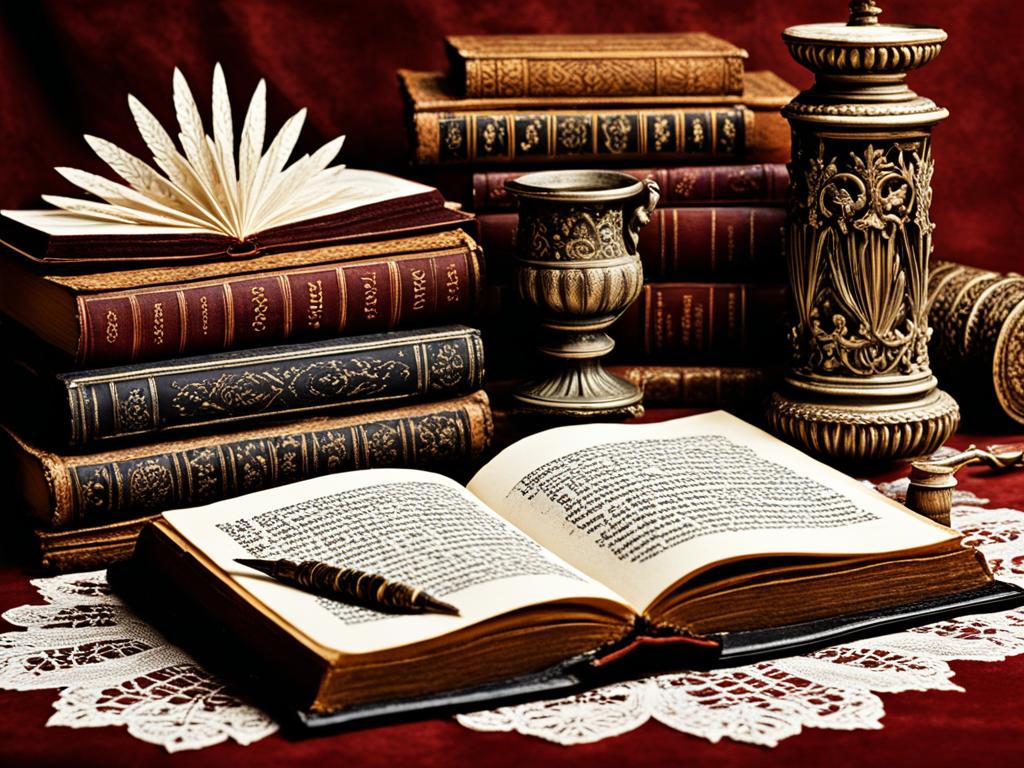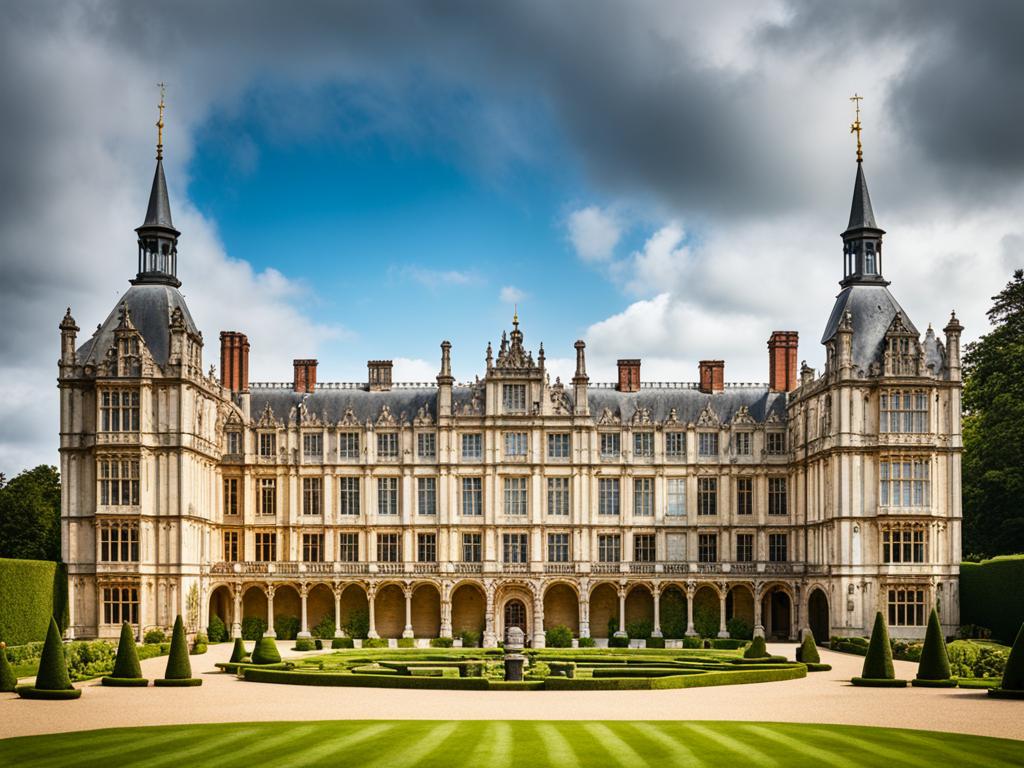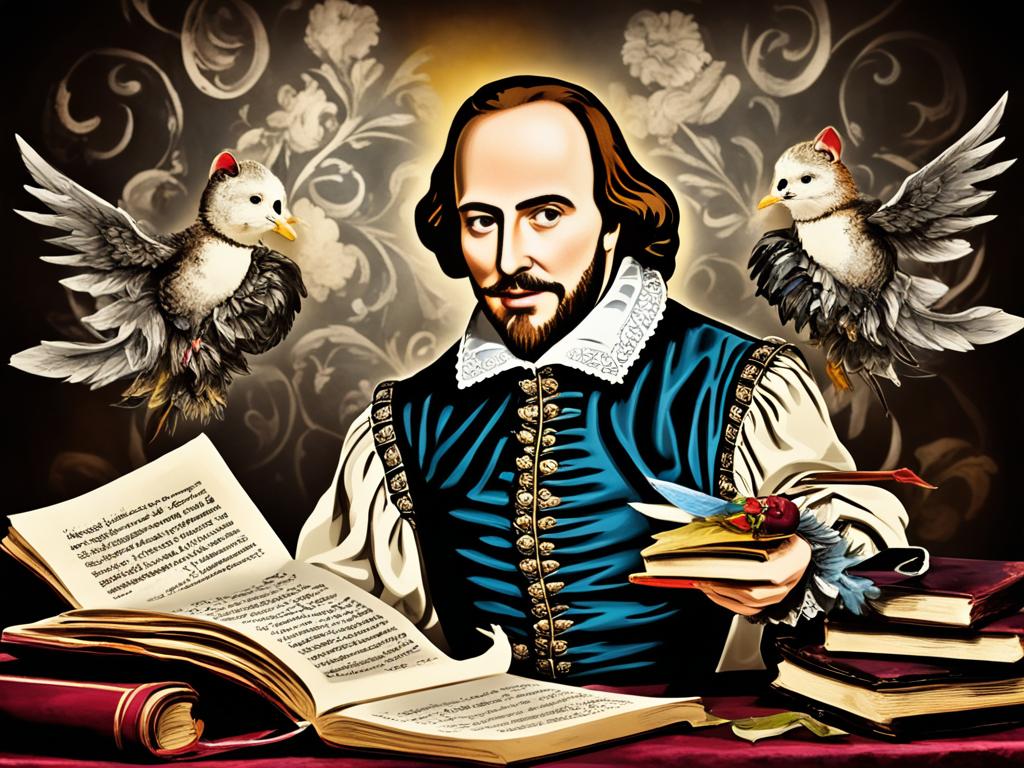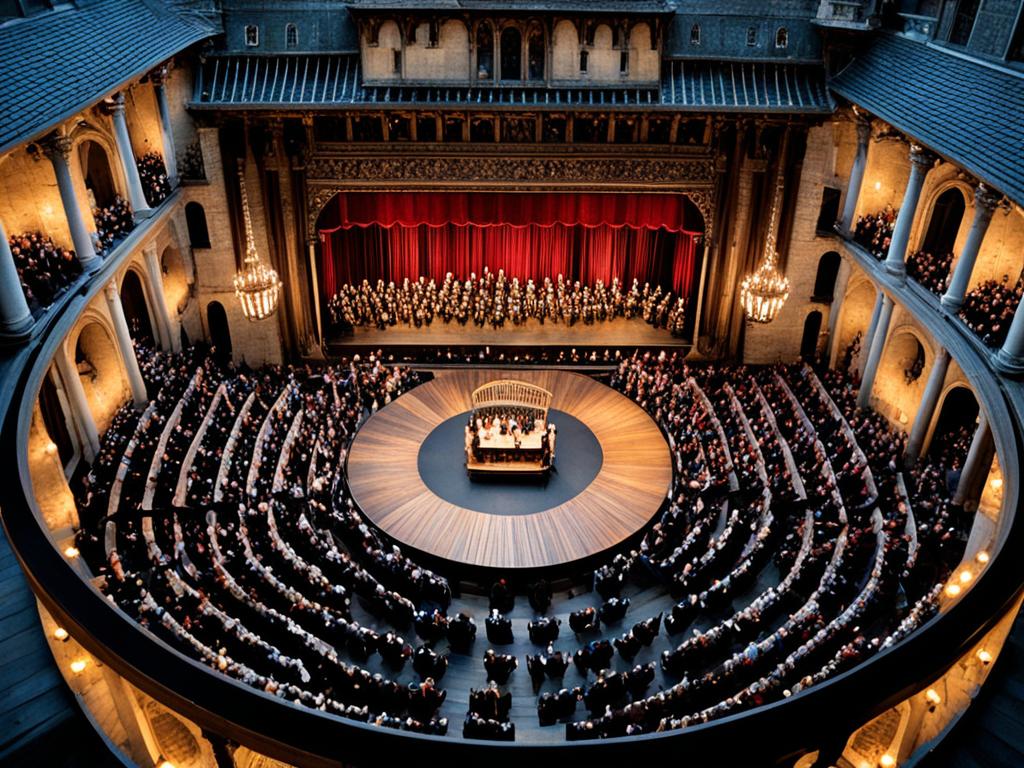
Elizabethan Era: Golden Age of English History, Literature & Poetry
The Elizabethan Era lasted from 1558 to 1603. It was a key time in English history, literature, and culture. Named after Queen Elizabeth I, it’s known as the “Golden Age” of England. This era saw big steps forward in many areas, like the rise of the Tudor dynasty and the growth of the English Renaissance.

England went through a big cultural and artistic change during this time. This change has had a big effect on the nation’s heritage and its influence around the world. The era was full of new discoveries in architecture, science, and exploration. It also brought to life some of the most famous figures in English literature, like the great playwright William Shakespeare.
The Elizabethan period is seen as a golden age in British history. It was a time when England’s power in politics, economy, and culture was at its peak. This era is still fascinating to scholars, artists, and people all over the world. It shows the lasting impact of the Elizabethan Era.
Introduction to the Elizabethan Era
The Elizabethan Era was a time of great peace and growth in England. It came after the hard times of Henry VIII and his children. Queen Elizabeth I brought peace, wealth, and a strong sense of who they were.
The Tudor family ruled from 1485 to 1603. They greatly influenced the politics, society, and culture of the Elizabethan Era.
Historical Background
This era saw big changes in politics and society. The Tudors became more powerful and solved the religious fights that troubled the past. Queen Elizabeth I ruled from 1558 to 1603 and made England a world leader.
She expanded trade and explored new lands. This made England strong and proud.
Cultural and Artistic Significance
The Elizabethan Era is known as the “English Renaissance.” It was a time of great culture and art. Elizabethan literature, architecture, and theater were all thriving.
Playwrights like William Shakespeare became famous. Their plays are still loved today. Elizabethan poetry and art also showed the era’s beauty and curiosity.

The Elizabethan Era was a key time in British history. It was known for peace, new ideas, and a strong national identity. The Tudors and the Elizabethan Renaissance still influence England’s culture today.
The Elizabethan Era in English Literature
The Elizabethan Era, from 1558 to 1603, is seen as the golden age of English literature. Queen Elizabeth I’s reign was marked by a literary boom. At the heart of this era was william shakespeare, a famous playwright. His works changed the English language and literature forever.
William Shakespeare and His Works
william shakespeare, known as the “Bard of Avon,” is a top playwright of all time. His plays like “Hamlet,” “Romeo and Juliet,” and “Macbeth” are known for their deep characters and complex stories. Shakespeare’s work has made him a literary legend.
He also wrote beautiful poetry, including the famous “Sonnets.” These poems show his skill with words and deep understanding of life and love.
The Elizabethan era was a time of great creativity, with william shakespeare leading the way. His work has had a lasting impact on elizabethan theatre and literature. His artistic vision continues to inspire us today.

Elizabethan Poetry: Exploring the Poetic Renaissance
The Elizabethan era was a time of great change in poetry. Poets like Edmund Spenser, Philip Sidney, and John Donne made big impacts. They explored many themes and forms, from the pastoral to the metaphysical.
Elizabethan poetry was known for its beauty, complexity, and new language use. Poets tried out different forms like the sonnet and the villanelle. They pushed the English language’s limits, creating works that still move readers today.
Edmund Spenser is seen as the father of English poetry. His epic poem, The Faerie Queene, mixed allegory, romance, and politics. It shows the culture and thought of the Elizabethan time.
Philip Sidney was another key poet. His Astrophil and Stella sonnets looked at love and desire deeply. Sidney’s poems were known for their beauty and feeling, influencing many poets after him.
Metaphysical poets like John Donne also appeared during this time. Their poems were full of deep thought, religious themes, and new metaphors. Donne’s poems, with their sharp wit and style, are still studied and loved today.
The Elizabethan poets have left a big mark on English poetry. Their works show the beauty and variety of the Elizabethan poetic renaissance.

“Poetry is the record of the best and happiest moments of the happiest and best minds.” – Percy Bysshe Shelley
Elizabethan Era in English History
The Elizabethan Era was marked by Queen Elizabeth I’s rule, the last of the Tudor dynasty. Her nearly 45-year reign brought stability and prosperity to England. This made England a major European power. The Tudor dynasty, starting with Henry VII and ending with Elizabeth I, greatly influenced England’s politics, religion, and culture.
Exploration and Expansion
During the Elizabethan Era, England explored and expanded its global presence. Explorers like Sir Francis Drake and Sir Walter Raleigh led expeditions. These journeys expanded England’s world knowledge and helped grow the British Empire.
New trading routes and colonies also boosted England’s economy and politics during this time.

The era’s exploration and expansion made Britain a leading world power. These efforts laid the groundwork for the British Empire’s future growth. This empire would influence world history for many centuries.
The Elizabethan Theatre and Its Influence
The Elizabethan era was a time of great growth for professional theatre. It was the golden age for the performing arts, with the first permanent playhouses in London, like the famous Globe Theatre. William Shakespeare was a key figure, changing Elizabethan theatre with his stories and dramatic techniques.
The Rise of Professional Theatre
Before the Elizabethan era, plays were often held in temporary spots or inn-yards. But as people wanted more live shows, dedicated theatres were built. This marked the start of a new level of professionalism in theatre.
These Elizabethan playhouses were not just for fun. They also showed the social, political, and cultural issues of the time. They left a lasting mark on culture.
The Elizabethan theatre was a place of creativity, drawing in people from all walks of life. Writers like Shakespeare, Marlowe, and Jonson told stories that touched on love, tragedy, and human nature. Their plays made people think and see things in new ways.
“All the world’s a stage, and all the men and women merely players.” – William Shakespeare, As You Like It
The Elizabethan theatre’s impact is still seen today. Shakespeare’s works, the design of the playhouses, and the era’s cultural importance have all left a mark. This theatre has inspired and shaped the arts for centuries.

Conclusion
The Elizabethan’s Era was a key time in England’s history. It left a lasting impact on literature, art, and culture. Queen Elizabeth I led the Tudor dynasty, bringing peace, wealth, and a burst of creativity.
William Shakespeare became a famous writer during this time. His works still thrill people all over the world. The era also saw a rise in poetry, creating beautiful works that have lasted for centuries.
Exploration and the British Empire grew during this era. This made England more influential globally. The Elizabethan Era’s impact is still felt today. Its art and ideas are still important in our culture.
Today, the Elizabethan Era’s legacy lives on. Its literature and ideas are still studied and admired. Reflecting on this era shows us the big changes and successes of British history. The renaissance, Elizabethan era, and British history are all connected to this time.
FAQ
What was the Elizabethan Era?
The Elizabethan’s Era was a key time in English history, lasting from 1558 to 1603. It’s named after Queen Elizabeth I. This era is known as the “Golden Age” of England. It saw big steps forward in many areas, like the rise of the Tudor dynasty and the English Renaissance.
What was the historical and cultural significance of the Elizabethan Era?
This era brought peace and growth to England after a tough time. Queen Elizabeth I’s rule brought stability and made England prosperous. The Tudor dynasty helped shape the era’s politics, society, and culture. It was also a time of great cultural and artistic achievements, known as the “English Renaissance.”
Who was William Shakespeare, and what was his impact on Elizabethan literature?
William Shakespeare was a famous playwright from the Elizabethan Era. He’s seen as one of the most important figures in literature. His plays, like “Hamlet” and “Romeo and Juliet,” have changed the English language and literature forever. Shakespeare’s skill in writing and creating characters made him a giant of Elizabethan literature.
What were the key achievements in Elizabethan poetry?
The Elizabethan’s Era saw a big growth in poetry, with many talented poets. Poets like Edmund Spenser and John Donne explored different themes and styles. Their work added depth and richness to Elizabethan poetry.
How did the Tudor dynasty and Queen Elizabeth I shape the Elizabethan Era?
Queen Elizabeth I, the last Tudor monarch, ruled for nearly 45 years. Her rule brought peace and made England a major power in Europe. The Tudor dynasty, starting with Henry VII and ending with Elizabeth I, greatly influenced England’s politics, religion, and culture during this time.
What was the significance of the Elizabethan theatre?
The Elizabethan’s Era saw the start of professional theatre with the Globe Theatre in London. This was a golden age for theatre, with famous playwrights like William Shakespeare. Their work changed theatre with new stories and dramatic styles. Elizabethan theatre was not just for fun but also showed the era’s social and cultural issues, leaving a lasting impact.



Elizabethan era was very good cause it’s brought English and creativity.
A Great Era indeed